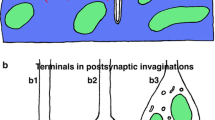Summary
The radial nerve cords of members of the class Ophiuroidea consist of two parts, the ectoneural and the hyponeural tissues, which are separated by an acellular basal lamina. The hyponeural tissue is composed entirely of motor fibres. The cell bodies of the hyponeural neurones are arranged in ganglia, one to each segment of the arm, and each containing approximately one hundred cell bodies. Synaptic contact between the two tissues occurs across the basal lamina. Ultrastructural evidence shows that the majority of these synapses operate in the ectoneural to hyponeural direction. Three pairs of nerve bundles, each containing approximately thirty five large motor fibres arise from each ganglion and innervate the intervertebral muscles. The large motor fibres divide into a number of pre-terminal axons in the region in which the motor fibre enters the muscle block. The terminal axons run at right-angles across the muscle fibres and neuromuscular junctions are found at the points of contact between the two; each terminal axon makes contact with a large number of muscle fibres. The hyponeural axons also pass through the juxtaligamental tissue before they reach the muscle blocks and there is some evidence of synaptic contact with the juxtaligamental cells. The juxtaligamental tissue is thought to be associated with changes in the structural properties of the collagenous ligaments of the arm during arm autotomy (Wilkie 1979). Degeneration studies confirmed the layout of the hyponeural motor axons.
Similar content being viewed by others
References
Bachmann S, Phola H, Goldschmid A (1980) Phagocytes in the axial complex of the sea urchin, Sphaerechinus granularis (Lam.) Cell Tissue Res 213:109–120
Baur PS, Stacey TR (1977) The use of PIPES buffer in the fixation of mammalian and marine tissue for electron microscopy. J Microscopy 109:315–327
Christo-Apostolides N (1882) Anatomie et dévelopment des Ophiures. Arch Zool Exp Gen 10:121–224
Cobb JLS (1970) The significance of the radial nerve cords in asteroids and echinoids. Z Zellforsch 108:457–474
Cobb JLS (1967) The innervation of the tubefeet in the starfish Astropecten irregularis. Proc Roy Soc B 168:91–99
Cobb JLS, Laverack MS (1966) The lantern of Echinus esculentus (L.). III. The fine structure of the lantern retractor muscle and its innervation. Proc Roy Soc B 164:651–658
Cobb JLS, Pentreath VW (1978) Comparison of the morphology of synapses in invertebrate and vertebrate nervous systems. Prog Neurobiol 10:231–252
Cobb JLS, Stubbs TR (1981) The giant neurone system in Ophiuroids. I. The general morphology of the radial nerve cords and circumoral nerve ring. Cell Tissue Res 219:197–207
Coleman R (1969) The ultrastructure of the tubefoot sucker of the regular echinoid Diadema antillarum (Phillipi.), with especial reference to secretory cells. Z Zellforsch 96:151–161
Cuenot L (1888) Etudes anatomiques et morphologiques sur les Ophiures. Arch Zool Exp Gen 2 me série T 6:33–82
Dietrich HF, Fontaine AR (1975) A decalcification method for ultrastructure of echinoderm tissue. Stain Tech 50:351–354
Hamann O (1889) Anatomie der Ophiuren Crinoiden. Jena Z Naturw 23:223–338
Holland ND, Nealson KH (1978) The fine structure of the cuticle and the sub-cuticular bacteria of echinoderms. Acta Zool (Stockh) 59:169–185
Hylander BL, Summers RG (1975) An ultrastructural investigation of the spermatozoa of two ophiuroids, Ophiocoma echinata and Ophiocoma wendti: Acrosomal morphology and reaction. Cell Tissue Res 158:151–168
Hyman L (1955) The invertebrates. Vol. IV Echinodermata. McGraw-Hill, New York
Pentreath VW, Cottrell GA (1971) “Giant” neurons and neurosecretion in the hyponeural tissue of Ophiothrix fragilis. J Exp Mar Biol Ecol 6:249–264
Prosser CL, Mackie GO (1980) Contractions of Holothurian muscles. J Comp Physiol 136:103–112
Smith JE (1950) Some observations on the nervous mechanisms underlying the behaviour of starfishes. Symp Soc Exp Biol 4:196–220
Spurr AR (1969) A low viscosity embedding medium for electron microscopy. J Ultrastruct Res 26:31–43
Wilkie IO (1979) The juxtaligamental cells of Ophiocomina nigra and their possible role in the mechano-effector function of collagenous tissue. Cell Tiss Res 197:515–530
Author information
Authors and Affiliations
Rights and permissions
About this article
Cite this article
Stubbs, T.R., Cobb, J.L.S. The giant neurone system in ophiuroids. Cell Tissue Res. 220, 373–385 (1981). https://doi.org/10.1007/BF00210515
Accepted:
Issue Date:
DOI: https://doi.org/10.1007/BF00210515




